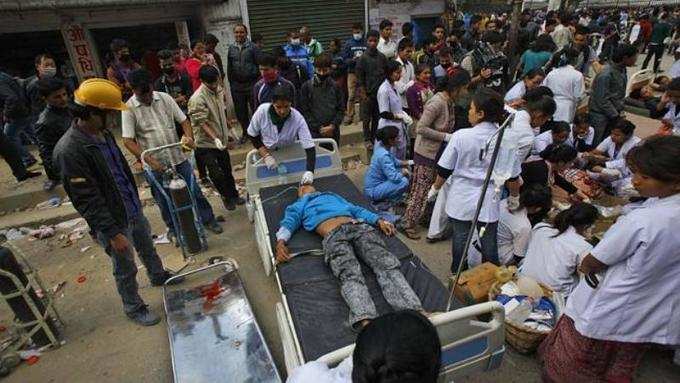 Even as video footage after another show how doctors are treating the injured on the streets, having run out of space inside the hospital compounds, this massive
Even as video footage after another show how doctors are treating the injured on the streets, having run out of space inside the hospital compounds, this massive
The country of 28 million has only 2.1 physicians and 50 hospital beds for every 10,000 people, according to a 2011
The situation is worsening a humanitarian crisis triggered by Nepal's worst earthquake in 81 years. The 7.9 quake, which struck just before noon on Saturday, has killed more than 2,200 people and injured more than 5,400.
Casualties are expected to rise, as many more people are feared trapped in debris across the country, from the capital
So far many of the seriously injured in Kathmandu were being referred to
Doctors said they needed more than 1,000 more beds to treat the patients that were being brought in ambulances and taxis.
"The earthquake has exposed that Nepal's best public hospital infrastructure has crumbled at a time when it should serve more people in a hurry," said Sarvendra Moongla, a
Children with multiple injuries were laid on the dusty marble floors of the hospital, while hundreds of other patients with fractured and bloodied limbs lay on the ground outside the hospital under tents as family members struggled to find drinking water and food for them.
A lack of morgue facilities meant that 13 bodies lay outside the hospital, one of the oldest in Nepal.
Many patients were prematurely discharged to accommodate the waves of injured
Anita Dhungana, 31, said she was admitted to the trauma center last week and operated on just hours before the quake. Doctors had advised 48 hours of bed rest in the hospital.
"My father begged and pleaded before the doctor to keep me in the hospital. I am still bleeding and cannot walk but there is no one to examine me," Dhungana said.
Her father pitched a tent near a sewage pit where survivors washed their faces and cooked rice with lentils on kerosene stoves.
Outside the
He said he had been evacuated from Mount Everest base camp, where an avalanche triggered by the quake killed at least 17 climbers and injured scores.
While Nepal's healthcare facilities are limited, they quickly become much worse outside its major cities. Remote regions have only very basic medical centres that are ill-equipped to handle serious injuries.
